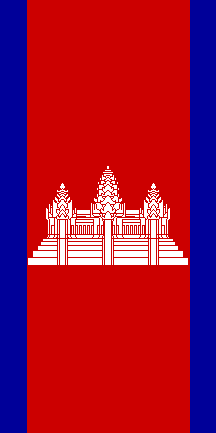![[Cambodia]](../images/k/kh.gif) image by P. Mattew and Eugene Ipavec, 8 October 1996
image by P. Mattew and Eugene Ipavec, 8 October 1996Proportions: 2:3
Usage Code:

Last modified: 2007-11-10 by phil nelson
Keywords: cambodia | khmer | angkor wat | temple | francophonie |
Links: FOTW homepage |
search |
disclaimer and copyright |
write us |
mirrors
![[Cambodia]](../images/k/kh.gif) image by P. Mattew and Eugene Ipavec, 8 October 1996
image by P. Mattew and Eugene Ipavec, 8 October 1996
Proportions: 2:3
Usage Code: ![]()
Local Name:
ព្រះរាជាណាចក្រ
កម្ពុជា
ISO Code: KH KHM 116
FIPS 10-4 Code: CB
MARC Code: cb
IOC Code: CAM
The Kingdom of Cambodia is one of the most ancient monarchies in the world. Until 1947, year of the promulgation of a democratic Constitution by King Norodom Sihanouk Varman and the organization of the first elections of universal suffrage, the national flag has 3 colors - blue, red, white - differently placed, the Blue, surrounding the whole, symbolizing the Royalty, the Red, the Nation, the White, the Religion, at the beginning of Brahmanism, and now with the majority of Buddhism.
The present flag with these colors arranged in horizontal bands, was
officially adopted on October 29, 1948
until October 1970, then, once again, at the beginning of September 24, 1993,
date of the reestablishment of the Monarchy. The central emblem represents the
towers of Angkor Wat - Angkor being the only popular pronunciation of Norkor,
Wat signifying Temple - seen from the front view. In the Khmer cosmology, the
pedestal of the temple represents the Mount Meru, structure of the Universe,
the top being the central sanctuary of Cambhu the kind lord creator of the
world, divinity of predilection of the King founder. This symbol appears again
on the coin which was struck around 1847, under the reign of Ang Duong and
which was abolished under Norodom. The King was the intercessor between the
sky and the land, between the gods and men. Nowadays, the national flag
reflects the trilogy of Nation, Religion and King, motto of the Khmer
monarchy.
According to sources (letter dated 04 03 99 from the French Attaché, my
translation) "..the Cambodian constitution dated 21 September
1993 defines the flag and coat-of arms by
graphic representation and no official text.." and in same letter a
design with black and white temple (as in Album 2000 [pay00]) (message from same
origin dated 27 April 95, my translation)"...the Defence Attaché
confirms that the stylized architecture of Angkor temple is presented with
black lines.."
Armand du Payrat, April 2001
1991-93 Coat of Arms
![[1991-1993 Cambodia Coat of Arms]](../images/k/kh)dk.gif) image by Mikhail Revnivtsev
image by Mikhail Revnivtsev
Between October 1991 and June 1993, under the UN administration (UNTAC =
United Nations Transitional Authority in Cambodia) Cambodia used this
Coat of Arms.
Jens Pattke, 29 January 2003
Royal Standard. 2:3 - Blue flag with the royal emblem in gold outline.
Željko Heimer, 19 April 2001
One should speak of royal arms. In this case also, many are the reported
versions. The arms showed two cups placed one over the other; over them a
sacred sword placed horizontally surmounted by a symbol representing
"om" the sound of creation . Under the whole two laurel branches
united at the bottom by the star of the Royal Order of Cambodia. The image
here is a late version of this coat of arms, but all the basic elements are
included
Mario Fabretto, 15 June 1997
 image by Ivan Sache and P. Mattew
image by Ivan Sache and P. Mattew
In an exhibition about South-East Asia, there was a picture of a pagoda in Phnom-Penh, the capital of Cambodia. Buddhism is the official religion of Cambodia.
The pagoda entrance was decorated with several vertical monochrome banners, as often seen in Buddhist areas. The gate was flanked by two vertical Cambodia national flags. The flags were apparently "non-standard", because:
Ivan Sache, 19 November 2000
In a local political magazine I saw a photo from Phnom-Phen taken recently
showing, among other things, the lamp posts in the (main?) street decorated
with vertically hoisted flags of Kambodia, with the Angkhor rotated and set
near the top. The one used on the photo was with stripe ratio similar to the
national flag, the temple at the top and considerably longer (hard to tell how
much, as the lower end is lost between the trees in the avenue, but at least
1:4).
Željko Heimer, 7 September 2003